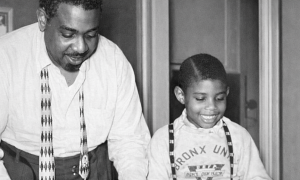Home » Jazz Articles » Book Review » Drums & Demons: The Tragic Journey of Jim Gordon
Drums & Demons: The Tragic Journey of Jim Gordon
 Drums & Demons: The Tragic Journey of Jim Gordon
Drums & Demons: The Tragic Journey of Jim Gordon Joel Selvin
288 Pages
ISBN: #978-1635768992
Diversion Books
2024
In keeping with the title of Drums & Demons, Joel Selvin's account of The Tragic Journey of Jim Gordon is a schizophrenic piece of work. A seasoned journalist who's distinguished himself with a disinterested yet frank objectivity in past publications like Altamont: The Rolling Stones, the Hells Angels, and the Inside Story of Rock's Darkest Day (Dey Street, 2016) and Fare Thee Well: The Final Chapter of the Grateful Dead's Long, Strange Trip (Da Capo, 2018), the author hardly sounds like himself in Part I.
Straining for effect, he overuses hyperbole, thereby generating an abundance of so-called "purple prose" in an awkward effort to make his point(s): "some supernatural power made Jim Gordon a better drummer than anyone else." Such a declaration begs the question of whether the native Californian was superior to his own heroes of the kit, Earl Palmer and Hal Blaine (titular leader of "The Wrecking Crew" of in-demand studio pros). In fact, the first half of these two-hundred pages are worth reading mostly to learn of the panoply of personalities, celebrity and otherwise, with whom the late drummer worked during the course of his illustrious career. Collaborating with the likes of Phil Spector, Brian Wilson, Neil Young and Eric Clapton might well be enough to justify a biography on merely practical terms, so it's really not necessary for Selvin to continue with so much overinflated sentiment as graces the back cover blurb here: "legends in awe of his superior playing"?
Not surprisingly, the sporadically overwritten content also begs the question of the editing applied to maintain well-paced word flow. The pace is absolutely breathless and not to a wholly effective purpose: was Selvin rushed to finish the project? Ironically, however, that lamentable facet of this book only makes for a more stark contrast with Part II. Here is the passionate but keenly discerning observer in this writer. The change in tone all the more laudable since it is here Selvin's covering that portion of Gordon's career where he mingles with and works alongside the most famous people he ever encounters, including various Beatles, a former member of The Byrds (Chris Hillman of Souther Furay) and the ageless Steve Winwood of Traffic.
This is a suspenseful read here too, even though the outcome of the tale has already been widely publicized. Jim Gordon's mental illness(es), camouflaged by indulgences in drink and drugs, plus a work ethic out-of-control, adversely affect his state of mind until it reaches a nadir of delusion that compels him to murder his mother in 1983.
Joel Selvin's carefully-wrought narrative captures the inexorable deterioration of Jim Gordon's psyche and he explicates what might seem an inevitable sequence of events. Nevertheless, the drama remains palpable, as much or more so as the sadness that arises from his subject's excruciatingly slow demise; the instincts that led to superlative musicianship morphed into an increasingly loud and overwhelming inner dialogue.
Intentionally or not, Drums & Demons is an accurate reflection of the personality that is its subject. The sixteen pages of photos spanning Jim Gordon's career substantiate his whirlwind life and times, most emblematic of which are the extravagant enterprises in the forms of Delaney & Bonnie and Friends, then Mad Dogs & Englishmen. Both initiatives stand as metaphors of good intentions gone awry due to ego.
While Joel Selvin might've adopted a somewhat more temperate and measured attitude in his depiction of The Tragic Journey of Jim Gordon, this tome is ultimately effective as a rise-and-fall story of a single man caught up in the maelstrom of his era. And, intentionally or not, the range of wild tales within renders it more rather than less indicative of the decadence of its times.
From his wizened point of view on Drums & Demons, the veteran journalist/author reaffirms in no uncertain terms that the lack of self-restraint on the part of those hallowed denizens of the Sixties and Seventies undermined the culture's creative and artistic tendencies as much as it uplifted them.
Tags
Book Review
Jim Gordon
Doug Collette
Diversion Books (
Earl Palmer
Hal Blaine
Phil Spector
Brian Wilson
Neil Young
Eric Clapton
The Byrds
Chris Hillman
Steve Winwood
Traffic
Derek and the Dominos
Delaney & Bonnie and Friends
Mad Dogs & Englishmen
PREVIOUS / NEXT
Support All About Jazz
 All About Jazz has been a pillar of jazz since 1995, championing it as an art form and, more importantly, supporting the musicians who make it. Our enduring commitment has made "AAJ" one of the most culturally important websites of its kind, read by hundreds of thousands of fans, musicians and industry figures every month.
All About Jazz has been a pillar of jazz since 1995, championing it as an art form and, more importantly, supporting the musicians who make it. Our enduring commitment has made "AAJ" one of the most culturally important websites of its kind, read by hundreds of thousands of fans, musicians and industry figures every month.























